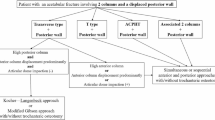Abstract
Purpose
To determine the optimal position of reduction clamps applied to reduce transtectal transverse acetabular fractures approached through the anterior intrapelvic route.
Methods
Transtectal transverse fractures were created in sawbone hemipelvis models. Fractures were reduced and held with a large pointed reduction clamp with one tine centered on the quadrilateral plate and the other placed in one of nine various positions on the pelvic brim accessible from the anterior intrapelvic (AIP) approach. Reduction was assessed by measuring maximum gapping and step-off at the joint surface.
Results
The posterolateral pelvic brim clamp position provided the most accurate reduction with the smallest articular fracture gap (mean 1.09 ± 1.05 mm) and step-off (mean 0.87 ± 1.35 mm). This clamp position, compared with the other positions as a whole, also yielded the highest proportion of perfect reductions (0 mm maximum displacement) for both step-off (83% vs 34%; RR 2.4, 95% CI 1.7–3.2) and gap (88% vs 49%; RR 1.8, 95% CI 1.4 to 2.2).
Conclusions
When clamping transtectal fractures through the AIP approach, positioning the clamp posterolaterally on the pelvic brim appears to provide the best reduction in this fracture model.






Similar content being viewed by others
References
Letournel E (1980) Acetabulum fractures: classification and management. Clin Orthop Relat Res 81–106
Matta JM, Mehne DK, Roffi R (1986) Fractures of the acetabulum. Early results of a prospective study. Clin Orthop Relat Res:241–250
Matta JM (1996) Fractures of the acetabulum: accuracy of reduction and clinical results in patients managed operatively within three weeks after the injury. J Bone Joint Surg Am 78:1632–1645
Briffa N, Pearce R, Hill AM, Bircher M (2011) Outcomes of acetabular fracture fixation with ten years’ follow-up. J Bone Joint Surg Br 93-B:229–236
Mears DC, Velyvis JH, Chang CP (2003) Displaced acetabular fractures managed operatively: indicators of outcome. Clin Orthop Relat Res 407:173
Oh CW, Kim PT, Park BC, Kim SY, Kyung HS, Jeon IH, Cheon SH, Min WK (2006) Results after operative treatment of transverse acetabular fractures. J Orthop Sci 11:478–484
Sagi HC, Afsari A, Dziadosz D (2010) The anterior intra-pelvic(modified Rives-Stoppa) approach for fixation of acetabular fractures. J Orthop Trauma 24:263
Andersen RC, O’Toole RV, Nascone JW, Sciadini MF, Frisch HM, Turen CW (2010) Modified Stoppa approach for acetabular fractures with anterior and posterior column displacement: quantification of radiographic reduction and analysis of interobserver variability. J Orthop Trauma 24:271
Isaacson MJ, Taylor BC, French BG, Poka A (2014) Treatment of acetabulum fractures through the modified Stoppa approach: strategies and outcomes. Clin Orthop Relat Res 472:3345–3352
Giannoudis PV, Grotz MRW, Papakostidis C, Dinopoulos H (2005) Operative treatment of displaced fractures of the acetabulum. A meta-analysis. J Bone Joint Surg Br 87:2–9
Dakin GJ, Eberhardt AW, Alonso JE, Stannard JP, Mann KA (1999) Acetabular fracture patterns: associations with motor vehicle crash information. J Trauma 47:1063–1071
Mauffrey C, Hao J, Cuellar DO 3rd, Herbert B, Chen X, Liu B, Zhang Y, Smith W (2014) the epidemiology and injury patterns of acetabular fractures: are the USA and China comparable? Clin Orthop Relat Res 472:3332–3337
Boudissa M, Francony F, Kerschbaumer G, Ruatti S, Milaire M, Merloz P, Tonneti J (2017) Epidemiology and treatment of acetabular fractures in a level-1 trauma centre: retrospective study of 414 patients over 10 years. Orthop Traumatol Surg Res 103:335–339
Ahmed M, Abuodeh Y, Alhammoud AJ, Salameh M, Hasan K, Ahmed G (2018) Epidemiology of acetabular fractures in Qatar. Int Orthop 42(9):2211–2217. https://doi.org/10.1007/s00264-018-3824-z
Chui KH, Chan CCD, Ip KC, Lee KB, Li W (2018)Three-dimensional navigation-guided percutaneous screw fixation for nondisplaced and displaced pelvi-acetabular fractures in a major trauma centre. Int Orthop 42(6):1387–1395. https://doi.org/10.1007/s00264-017-3659-z
Hsu C-L, Chou Y-C, Li Y-T et al (2019)Pre-operative virtual simulation and three-dimensional printing techniques for the surgical management of acetabular fractures. Int Orthop 43(8):1969–1976. https://doi.org/10.1007/s00264-018-4111-8
Sebaaly A, Riouallon G, Zaraa M, Upex P, Marteau V, Jouffroy P (2018) Standardized three dimensional computerised tomography scanner reconstructions increase the accuracy of acetabular fracture classification. Int Orthop 42(8):1957–1965. https://doi.org/10.1007/s00264-018-3810-5
Guimarães JAM, Martin MP, da Silva FR et al (2019) The obturator oblique and iliac oblique/outlet views predict most accurately the adequate position of an anterior column acetabular screw. Int Orthop 43(5):1205–1213. https://doi.org/10.1007/s00264-018-3989-5
Bible JE, Choxi AA, Kadakia Evans JM, Mir HR (2014) Quantification of bony pelvic exposure through the modified Stoppa approach. J Orthop Trauma 28:320–323
von Rüden C, Wenzel L, Becker J et al (2019) The pararectus approach for internal fixation of acetabular fractures involving the anterior column: evaluating the functional outcome. Int Orthop 43(6):1487–1493. https://doi.org/10.1007/s00264-018-4148-8
Rollmann MF, Holstein JH, Pohlemann T et al (2018) Predictors for secondary hip osteoarthritis after acetabular fractures—a pelvic registry study. Int Orthop. https://doi.org/10.1007/s00264-018-4169-3
Hak DJ, Hamel AJ, Bay BK, Sharkey NA, Olson SA (1998) Consequences of transverse acetabular fracture malreduction on load transmission across the hip joint. J Orthop Trauma 12:90
Malkani AL, Voor MJ, Rennirt G, Helfet D, Pedersen D, Brown T (2001) Increased peak contact stress after incongruent reduction of transverse acetabular fractures: a cadaveric model. J Trauma 51:704–709
Acknowledgements
We would like to thank Jason Nadeau for his assistance in data collection and manuscript preparation.
Author information
Authors and Affiliations
Corresponding author
Ethics declarations
The views expressed herein are those of the author and do not necessarily reflect the official policy or position of the Department of the Navy, Department of Defense, nor the U.S. Government.
Conflict of interest
The authors declare that they have no conflict of interest.
Additional information
Publisher’s note
Springer Nature remains neutral with regard to jurisdictional claims in published maps and institutional affiliations.
Level of evidence: Basic Science
Rights and permissions
About this article
Cite this article
Crump, E.K., Hwang, J., Vintimilla, D.R. et al. Posterolateral clamp placement on the pelvic brim provides optimal reduction of transtectal acetabular fractures fixed through the anterior intrapelvic approach. International Orthopaedics (SICOT) 44, 357–363 (2020). https://doi.org/10.1007/s00264-019-04430-x
Received:
Accepted:
Published:
Issue Date:
DOI: https://doi.org/10.1007/s00264-019-04430-x




